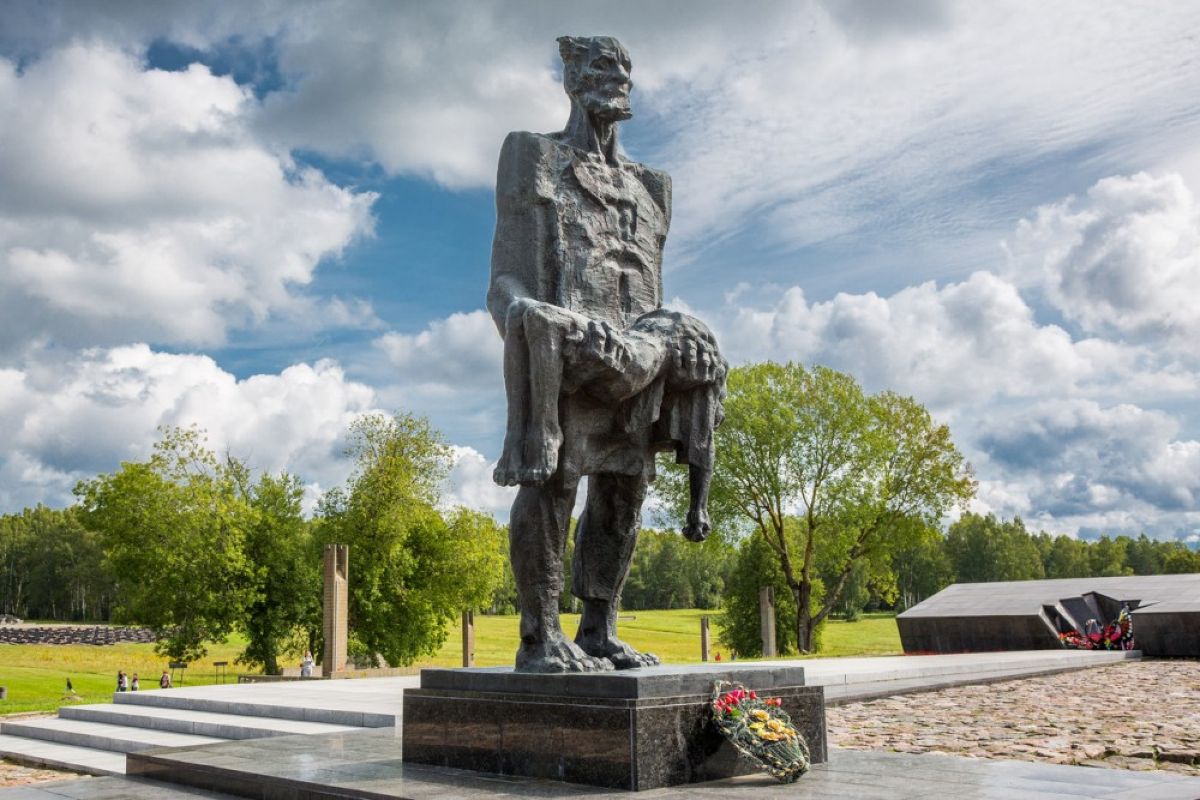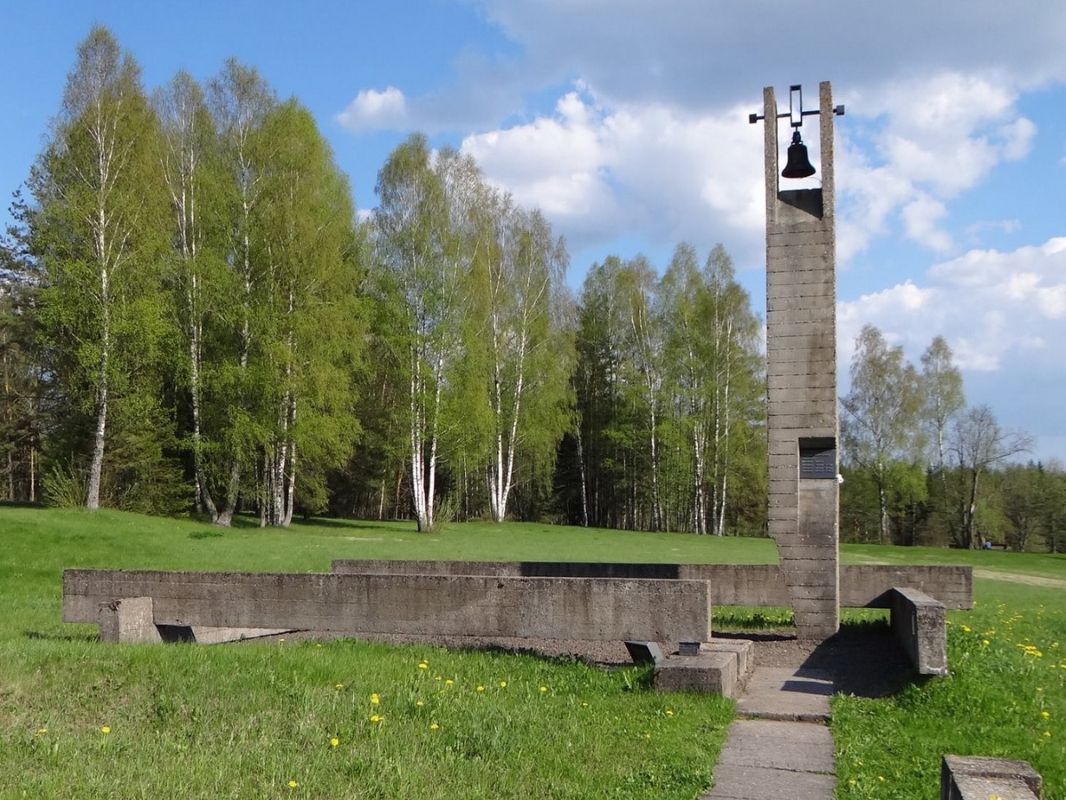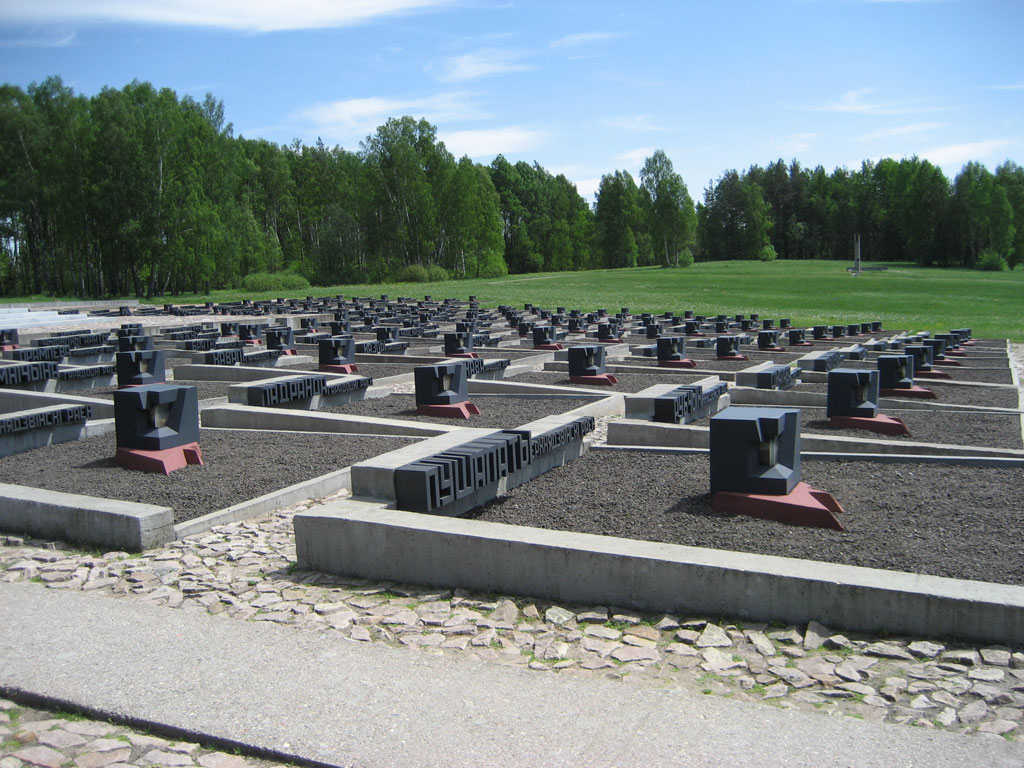The “Cemetary of the Villages”
Recollection of a visit to the Belarusian memorial site Khatyn on 13 October 1988
by Leo Ensel*
ef. 22 March 2023 marked the 80th anniversary of the tragedy of Khatyn in Belarus. It was there that the SS Sonderkommando Dirlewanger carried out a terrible massacre. Today, the memorial site built on 50 hectares at this location is a sacred place for the Belarusian people. A place of remembrance and mourning for all the rural settlements that had been destroyed during the years of occupation, for hundreds of thousands of victims of the tormentors: burned alive, shot, beaten to death; old men, women and children. A quarter of the population of Belarus fell victim to the cruel extermination campaigns. Little or nothing is known about this in our country. To ensure that these tragic years are not forgotten, a compulsory lesson on the topic “What the bells of Khatyn tell us” (see below) has been established in all Belarusian schools since last year.
Leo Ensel, an expert on eastern countries, visited the memorial site of Khatyn in 1988 and had experiences there that have shaped his life and work to this day.
Almost 35 years ago, in perestroika times, in autumn 1988, I took part in a peace and reconciliation trip to the Soviet Union organised by the Peace Network of the YMCA (Young Men’s Christian Association). It took us to Minsk, Moscow and Leningrad, among other places. We wanted to see with our own eyes and hear with our own ears what crimes Germans had done to the people in the Soviet Union during the Second World War. In Belarus, we visited the memorial site Khatyn1. Here, on the route between Minsk and Vitebsk, there is a graveyard that is probably unique in the world: the “Cemetery of Villages”. A cemetery for 186 Belarusian villages that were torched by the Germans during the anti-Partisan struggle in 1943 and later never rebuilt. – A few months later after this visit, which has deeply impressed me, I wrote the following text:
Khatyn, the memorial for hundreds of destroyed Belarusian villages, for 260 camps on the territory of Belarus and for two and a half million people from Belarus, murdered by the Germans during World War II.
Auschwitz, Buchenwald and Bergen-Belsen – these were places that have always been associated with Nazi atrocities for me. But I had never heard of Khatyn until shortly before our trip to the Soviet Union. It was also news to me that there had been so many camps in the USSR. Yes, I had already known that the Russian population had suffered 20 million victims in the Second World War2. But what are numbers! Only concrete examples of flesh-and-blood people help the sluggish imagination to get going.
The tragedy of Khatyn
Khatyn is such an example. On 22 March 1943, all 150 inhabitants of the village were driven out of their houses into the village barn by the SS Sonderkommando Dirlewanger. A short time later, the barn was ablaze, as were all the other houses in the village. Except for the blacksmith Josef Kaminsky, all the inhabitants burned alive, including 75 children. Khatyn is only one of 186 Belarusian villages that were destroyed by the Germans and never rebuilt. But that is not all. 628 Belarusian villages were destroyed with all their inhabitants, as well as 4667 villages with part of their inhabitants.
You can see from the face of our Minsk tour guide Ludmila that the walk through Khatyn is a strain for her, too, every time. At times she has to pull herself together. We walk past the statue depicting Iosif Iosifovich Kaminsky. With wide eyes open and flowing hair, he carries the corpse of his son towards the viewer. Behind it, the chimneys and foundation walls of the 26 courtyards of Khatyn. This is all that remains of the houses. Cast in concrete, they still stand today. A bell hangs in each chimney, and every half minute a peal blows across the grounds. In each chimney, a plaque gives the names of the inhabitants of the house and the ages of the children. On the grave of the people of Khatyn, carved into a white marble slab, are the words: “Dear human fellows, remember: we loved life, and our Motherland, and you, dear ones. We were burned alive in the fire. Our request to all: let sorrow and sorrow turn into your courage and strength, so that you can establish peace and tranquility on earth forever. So that from now on, nowhere and never in a whirlwind of fires, life does not die!”
“Every number, every place, every name a cry”
Then the cemetery of the villages. 186 graves, one for each village. On the graves, urns containing soil from the respective village. There were 260 camps in Belarus alone3. In the niches of the long memorial wall, names and numbers are written on plaques. 40,000 dead, 80,000 dead, 200,000 dead. A total of 2,300,000 Belarusians lost their lives in the Second World War. Every fourth White Russian is missing. At the final memorial, three birch trees stand in the square. Where the fourth should stand, an eternal fire burns in remembrance.
Walking along the memorial wall from niche to niche, then from grave to grave through the village cemetery, I feel very alone. Never have I been so aware of how little we know about the German crimes against the peoples of the Soviet Union, never have I been so aware that we cannot escape from our historical guilt. Every number, every place, every name a cry. What will the many Russian people who also walk through this memorial feel?
“We ask the Russian people for forgiveness”
At the place where the three birch trees stand and the eternal fire burns, we lay down fresh flowers and a dove of peace, which a woman from our group made especially for this trip. And then something happens – I almost wrote: we are allowed to experience something – that our whole journey had probably been aiming at. Next to us, also at the eternal fire, is a group of travellers from Siberia. There are maybe 20-30 women and men, most of them probably forty to fifty years old. Ludmila has an idea: “Don’t you want to say something to these people?” And then she translates what the speaker of our group tells the people from Siberia: “We are a travel group of the West German YMCA. We have come to see with our own eyes and hear with our own ears what crimes our fathers and grandfathers committed against the Russian people. We confess this historical guilt and ask the Russian people for forgiveness.”
“The earth belongs to all of us ...
I don’t know when I last saw such attentive faces as those of the people from Siberia here. When Ludmila finished translating, something changed for all of us: The Russian men and women are crying heartbreakingly like children, and we, we have to cry with them. Suddenly the dam is broken. Never before have I experienced so strongly how grieving together can actually unite and liberate. The leader of the Siberian tour group answers us, and Ludmila translates again: “In Russia there is a saying: ‘The children can’t help what their parents did’. We are supposed to look forward, the earth belongs to all of us, just as the sun shines for all people.”
… just as the sun shines for all people”
Just as the sun shines for all people. I don’t know why this sentence struck me so deeply and why even now, months later, I am fighting tears as I write these lines. I don’t know, it was just a feeling that one almost never experiences in this strength. A feeling that we, all people in this world, belong together, that what happened must never be repeated and that I wish all people in East and West to be allowed to experience such an encounter. I believe that then wars would no longer be possible.
We distribute our leaflets with the Russian translation of the confession of guilt of the Protestant churches from both German states. They are read attentively by the Russian people. Crying together has made us free and happy, we can look into each other’s eyes as if we had been good friends for ages.
As we walk back to our coach, we notice that the bus of the Siberian group is parked right next to us. From the Russian bus many wave friendly, and then they come rushing out again, our sheets of paper with the confession of guilt in their hands. We should write something on it, they tell us. Somewhat helplessly, I draw the only Russian word I can write in Cyrillic – МИР – and its German translation: Frieden (peace). But what we write is not that important either. We would all like to give each other something as a souvenir.
МИР –
when people from East and West join hands
What remains? Never before have I experienced so strongly how much grief, but also how much readiness for forgiveness and warm friendship lies in the people of the Soviet Union and how important it is that we as Germans take the first step. Guilt, grief and forgiveness – these words are then no longer phrases when they are combined with encounters between people from East and West. Then the desire and the strength for a common future without war and violence can grow out of the common mourning.
Just as the sun shines for all people.
PS: If you want to know more about the massacres of the Wehrmacht and Einsatzgruppen in the Belarusian villages – and can bear it – you should definitely watch the film “Come and see/ Иди и смотри” by Elen Klimow from 1985.
See “Films that should be compulsory in grammar schools” (including “Come and see!”). •
1 The Belarusian memorial Khatyn is not to be confused with the memorial Katyn near Smolensk, where thousands of Polish officers rest, murdered by the Soviet NKVD in May 1940 by shot in the neck.
2 At that time, I too used the word “Russian” largely synonymously with “Soviet”. The fact that the actual number of Soviet victims was much higher, at 26,6 million, only became known in the 1990s.
3 Most of them were camps for Soviet prisoners of war.
First published by https://globalbridge.ch on 22 March 2023
* Dr. Leo Ensel (“Look at the other side”) is a conflict researcher and intercultural trainer with a focus on “Post-Soviet space and Central/Eastern Europe”. He is the author of a number of studies on the mutual perception of Russians and Germans, fear and nuclear armament, and on the social psychology of reunification. His main concern is overcoming false narratives, de-escalation and the reconstruction of trust.


